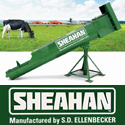 |
 |

|
|
|
Wisconsin Ag News Headlines |
 |
The Economics of Sustainable Corn Growing
Wisconsin Ag Connection - 01/23/2024
Agricultural sustainability has long been a buzzword but defies an easy definition. When AAE professor Paul Mitchell speaks with farmers, he likes to use safe driving as an analogy. âItâs hard to measure âsafe drivingâ but easy to measure driving below the speed limit,â says Mitchell. âBoth âsafe drivingâ and âsustainabilityâ are complex umbrella terms, so we need to define specific practices to study their value.â
In the case of agriculture, these are practices for raising livestock or growing crops. Most efforts to develop sustainable practices emphasize their environmental benefits. But those make up just one of the three pillars of agricultural sustainability. The other twoâeconomic profitability and social equityâare often underappreciated.
Focusing on economics can help farmers operate more sustainably without reducing their income. Thatâs why Mitchell and his U.S. Department of Agriculture (USDA) colleague, Fengxia Dong, used the example of U.S. corn growers to quantify the economic benefits of adopting sustainable practices.
Mitchell and Dong used the 2010 USDA Agricultural Resource Management Survey to analyze the responses of almost 1,800 conventional corn growers in 19 states to 73 questions about their use of sustainable practices. First, the researchers calculated sustainability scores, which convert the survey responses to a single number between 0 and 100. These scores are weighted sums of the reported practices, with lower weights for commonly used practices that do not help differentiate farms and higher weights for rarely adopted practices.
For example, a commonly used practice is the application of lime to corn fields to prevent soil from becoming too acidic. A much smaller number of farmers analyze within-field soil variability for precision lime application, where the amount of lime depends on soil texture, organic matter content and other features. Thus, lime application receives a lower weight than precision lime application. Other highly weighted practices include the use of advanced, non-chemical pest management strategies, planting crops other than corn during the last four years and installing terraces or other structures to reduce soil erosion.
The calculated sustainability scores were highly variable. Half the farms had scores between 50 and 75 and about 10% had scores below 25 or above 75. The sample average was 54.2. Next, the researchers analyzed how sustainability scores affected corn yield and farm income. They found that farmers who used more sustainable practices had a higher average income after controlling for other factors that influence revenue. For example, moving from the average score of 54.2 to the top 10% of scores increased the average income by 2.3%, mostly due to higher average corn yields and reduced variability.
However, using more sustainable practices resulted in more downside risk, or a higher likelihood of unusually low yields. This, says Mitchell, is what farmers are most nervous about. When the average net revenue is $15 per acre, many farmers arenât comfortable with, say, doubling the chance of losing $10 per acre from 3% to 6%.
Click here to read more wisc.edu
Other Wisconsin Headlines
|
|
 |


|
 |
|
Copyright © 2024 - Farms.com. All Rights Reserved. |
 |
|